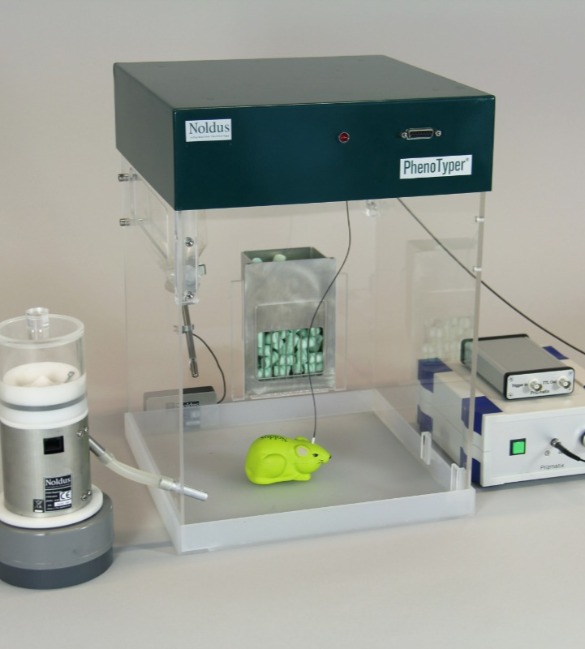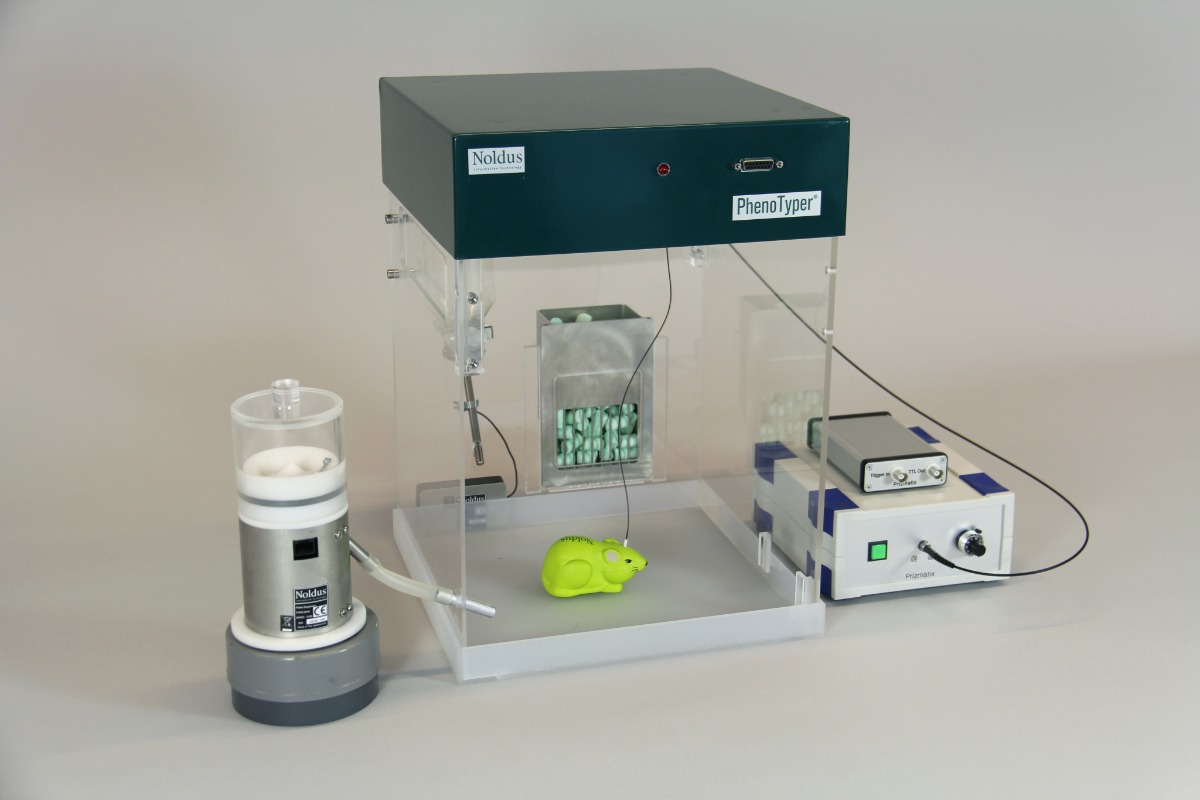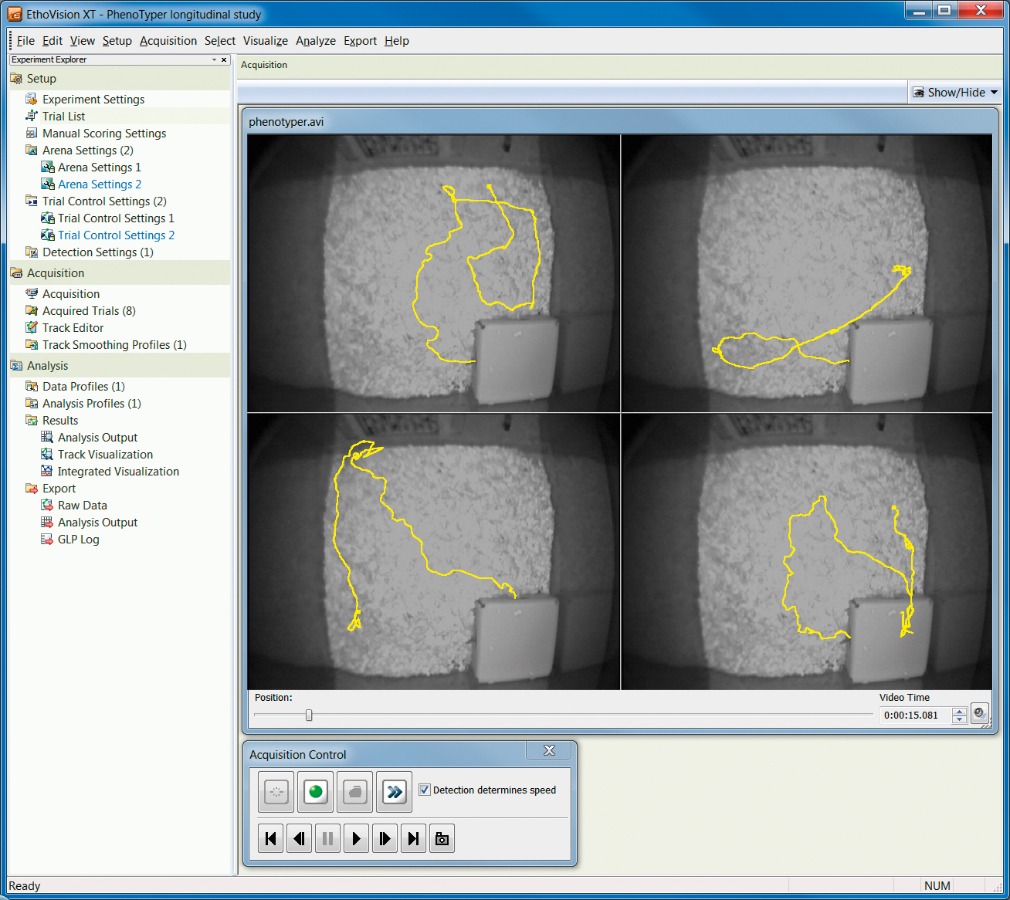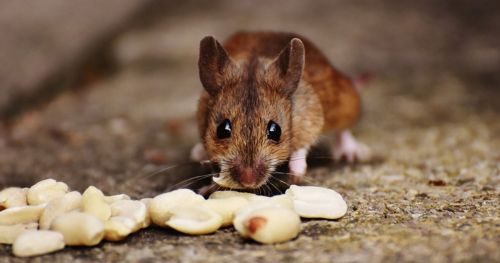Behavioral studies with
Optogenetics
In the last decade, a method was invented to specifically activate or even inhibit small groups of neurons with light. Today, scientists can insert light-sensitive receptor proteins (originally found in algae) into single mammalian neurons in Vivo, making these neurons sensitive to activation by light of specific wavelengths. This allows scientists to control the activity of these neurons and study their downstream influence on a variety of biological processes.

Easy integration with EthoVision XT and the PhenoTyper home cage
This is an important development for behavioral research. Not only can the actual influence of specific neurons on behavior more specifically be determined, but also, with the help of automatic video tracking systems, behavior can be manipulated via optogenetic methods in real time. This is where Noldus comes in: a perfect challenge for EthoVision XT and Trial & Hardware Control.

"EthoVision XT saves time, perhaps lives. In effect, PhD students can do more research in less labor-intensive time."
Dr. S. Adeosun|University of Mississippi Medical Center, USA
Trial and Hardware Control and optogenetics
Optogenetics can be used in a number of ways. For example, specific stimulation of neurons in brain areas with a known function can be used instead of drugs or electrode stimulation, thereby activating or inhibiting processes. By assessing the effect of this stimulation on animal behavior, one can gain insight into neuronal functioning.
EthoVision XT Trial and Hardware Control offers the opportunity to control this stimulation in behavioral assays. You can automatically turn the stimulus on or off based on behaviors detected by EthoVision XT. Compared to manually turning on stimulation, this offers better temporal precision. It is also a valuable method in longitudinal home cage studies.


How it works
Trial and Hardware Control is programmed within the EthoVision XT software. The intuitive interface is comprised of condition and action blocks that you can drag, drop, and connect to form the logic of your operant protocol. For example:
- When EthoVision XT registers specific behavior of the animal, such as being in a zone (think of place conditioning)
- When EthoVision XT registers a preference for a certain food that is offered
- EthoVision XT registers hardware feedback (such as lever presses in operant conditioning tasks)
- EthoVision XT registers a specific social interaction between one or more animals
- When conducting an off-on-off stimulus test (e.g. continuous stimulation for 5 minutes, preceded and followed by 5 minutes without stimulation)
Optogenetic stimulation devices
When programmed, EthoVision XT sends out signals via the USB IO-box that is connected to the device that provides stimulation to the animal (e.g. a laser or LED connected to fiber optics). These devices can be connected to, or built-into the PhenoTyper top unit. Examples of devices include those from Prizmatix.
Prof. Prévôt: "If therapeutics work in rodents, they can potentially be beneficial for human pathology."
Dr. Thomas Prévôt from the University of Toronto is developing a new tool to assess anxiety-like and depressive-like behavior in rodents, in order to understand the underlying mechanisms of chronic stress exposure and how it changes either behavior but also molecular and cellular pathology, to mimic the human depression.
Examples of research with optogenetics
The animal is placed in an arena with two distinct sides - one of which is paired with stimulation. Depending on whether this stimulation is activating or deactivating, and which neurons are affected, this can be a rewarding or aversive stimulus for the animal.
If in further sessions the animal spends more time on the stimulated sides, it is fair to conclude the stimulus had a rewarding effect. If the animal avoids this side, the stimulus could then be considered aversive [1,2,3].
In operant conditioning tests, the animal learns to press a lever or touch a sensor or perform another action in order to get a reward or prevent an aversive stimulus.
This behavior can be recorded with EthoVision XT, either by detecting the animal (or its nose point) in a certain zone, such as the feeder, or by analyzing the external signal initiated by the nose poke or lever press. Following this action, EthoVision XT sends out the command for stimulation [2,3].
Even in a straight-forward test, EthoVision XT Trial & Hardware Control proves to be valuable. A good example is an off-on-off stimulus test, where you can program EthoVision XT to turn stimulation on for a period of time during the test.
For example, Dr. Stuber describes a 15 minute test [1] during which continuous stimulation took place in the middle 5 minutes. In this case the anxiolytic or anxiogenic functioning of neurons was studied. The test took place in an elevated plus maze. If the animal spends significantly more time in the open arms of the plus maze (which is automatically assessed with EthoVision XT) during the stimulation phase, stimulation of the neurons are thought to have a anxiolytic effect.
Similar to the test described above, is the more general test of locomotion in response to stimulation. Velocity, movement, and even rotational movement are important behaviors and can tell a lot about the role of the neurons that are stimulated [1].

"Practical and user friendly software for behavior tracking, widely recommended."
Dr. A. Agoitia|National University of Mexico, Mexico
References
- Communication with Garret Stuber (www.stuberlab.org)
- Stamatakis, A.M.; Stuber, G.D. (2012). Activation of lateral habenula inputs to the ventral midbrain promotes behavioral avoidance. Nature Neuroscience, 15(8), 1105-1107.
- Kravitz, A.V.; Tye, L.D.; Kreitzer, A.C. (2012). Distinct roles for direct and indirect pathway striatal neurons in reinforcement. Nature Neuroscience, 15, 816-818.
Recent new publication combining live deep brain imaging with optogenetics: Jennings, J.H.; Ung, R.L.; Resendez, S.L.; Stamatakis, A.M.; Taylor, J.G.; Huang, J.; Veleta, K.; Kantak, P.A.; Aita, M.; Shilling-Scrivo, K.; Ramakrishnan, C.; Deisseroth, K.; Otte, S.; Stuber, G.D. (2015). Visualizing hypothalamic network dynamics for appetitive and consummatory behaviors. Cell, 160, 516-527.
Relevant blogs

 English
English German
German French
French Italian
Italian Spanish
Spanish Chinese
Chinese